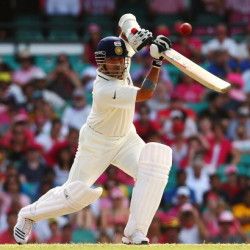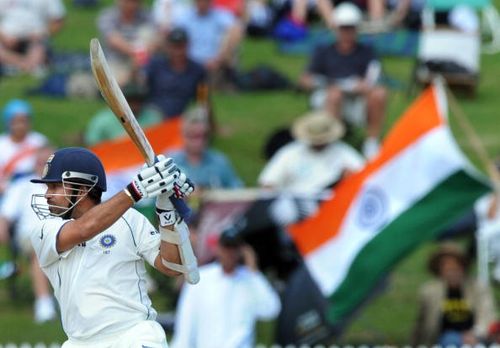
A perfect day in Chennai

The first part of the M. A. Chidambaram stadium that comes into view as one enters Chepauk from the heart of Chennai is the array of floodlights, towering over several modest commercial buildings. As you get closer, stretches of avant-garde white, triangular, plastic shading colorful seats become visible. And if by chance you go on the Saturday morning of an India-Australia Test match with a more than reasonable chance of the Little Master walking out to the crease at some point in the day, like I did, you will also see snake-like queues of people along the entire circumference of the stadium; young and old, male and female, waiting patiently for tickets to what, for many in India, is a semi-religious experience. And of such possible Saturdays, if you go there on the occasion of what may arguably be his final Test match at the venue, proud home to his magical performance against Pakistan in ’99, like I did, you would have watched a vintage Tendulkar innings, asterisked, the possibility of an extension to his greatness only a night’s sleep away.
I had a great seat for day two, right above the pavilion. The steps of the stand fell to a railing just above the Indian dressing room, against which waves of fans pressed every time Tendulkar walked towards and away from the dressing room (four times, I counted and watched, barely a pitch’s length away from the man). They were the kind of seats I always dreamed of as a kid but I rarely had access to. Before we could watch Him in his full splendour, though, we had to endure a delay in gratification (as is often the case with our cricket team), as Michael Clarke and Peter Siddle continued to patiently demonstrate to the Indian spinners their abject ordinariness on a pitch on which their forebears would wreak havoc.
It wasn’t until after a delayed lunch, after Clarke’s virtuoso performance ended at 130, after Harbhajan finally had occasion to look to the sky in thankfulness and Ashwin ended with career best figures, did the Indian innings start with local hero Murali Vijay, vying with Sehwag for the Chennai crowd’s enthusiasm (Sehwag won – ‘I came to watch him only’, moaned a 20-something seated close to me). At twelve for two, with timber flying all about the field, a hush fell over the ground as Sehwag trudged toward us in the longest walk of them all. Only for a moment though. The hush was followed by a slow rumbling as people processed the implications of Sehwag’s dismissal, and the rumbling turned into a roar as the Eureka moment came, a little late but excusably so. Bodies packed at the railing as if the region was a mosh pit; a short figure walked out briskly from the dressing room. His first action, as always, was to look up at the sky, wide-eyed, in what (for the fraction of second that it lasted) looked like devotion.
As the diminutive figure with such a formidable name walked in a measured manner to the centre, I felt the cosmic potential of the moment, like being on the edge of a cliff or the top of a hill, a moment away from a stage performance or a weighty confession to somebody dearly loved. The crowd, too, chanted as if drugged – Sachiiiiiiiiin, Sach-in, Sachiiiiiin, Sach-in – and all this in the few seconds (in real life) that lapsed during the Master’s walk. After the almost unconscious rituals of a batsman new at the crease followed by his idiosyncratic abdomen adjustment, he hunched his shoulders and was ready for a new innings. At the other end, James Pattinson was breathing fire. He was into his third over of truly quick and accurate bowling and ready for anybody, even God, so long as the batsman had timber behind him. He charged forward, shoulders down, head straight, ready to hurl down another bomb. Overhead, a few eagles soared effortlessly on the sea breezes that swirl above the stadium. Graceful and poised, they ride the breeze across the stadium, the blue expanse of the sea just beyond the stadium no doubt visible to them.

Pattison’s 144 kmph delivery found timber; the sweet spot in the middle of Tendulkar’s bat. He was half-crouched, his bat pointing to a region between point and cover, head and body perfectly still. With some batsmen, even great ones, the artifice of cricket is obvious. The moves are disjointed and forceful, even awkward. Kevin Pietersen is one such cricketer; great, no doubt, but with questionable aesthetic value in his batting. In the Tendulkar shot, ‘Sachin’ was completely absent. The movement of ball and bat were so continuous and the agent so still and invisible that only a seamless, pure shot remained – one continuous, almost perfect motion. Three balls and two boundaries later, it is unlikely that even a fully equipped death metal band would have been heard over the roar.
Tendulkar batted on through the rest of the afternoon. He defended the good balls and almost ruefully lodged the bad ones beyond the ropes. Grace and poise were imparted to every shot. It was not an extraordinary innings by any means, but it was a special one. It was measured, well-crafted and a deliberate innings where the batsman was in control throughout, just like so many dozens of his innings in the last two decades. It is this casual brilliance that is special, and more so because after all the discussions of his retirement, that thought is finally securely lodged in my mind. It is special because I know there will be so few more and most likely none in my hometown, where, after all, limited by a back strain, he had still almost beaten Pakistan in a heated, hostile tour.
The crowd too started the process of saying goodbye to Sachin. We said goodbye, and we will say it again tomorrow, and hopefully the two days after that too, shouting ourselves hoarse and egging him on with chants and Mexican waves, every breath in his name and praise containing a long, extended goodbye. Test cricket is not boring as long as the mundane is artful; that is the Little Master’s genius, and now that Dravid and Laxman are gone, I often think wistfully to myself – who else?
From the perfect seat to his performance, I watched him ease Nathan Lyon’s last ball to the ground and shake his bat contentedly in the follow through. It was stumps, and Virat and Sachin began the satisfied walk to the dressing room that follows a good day’s Test cricket. As they reached the boundary, Virat removed his helmet and slowed down almost imperceptibly, the waves of fans at the railing waving and chanting hysterically just above Sachin. He simply had to let Sachin cross the ropes first. I looked up at the sky, and sure enough, the eagles too had called it a day.